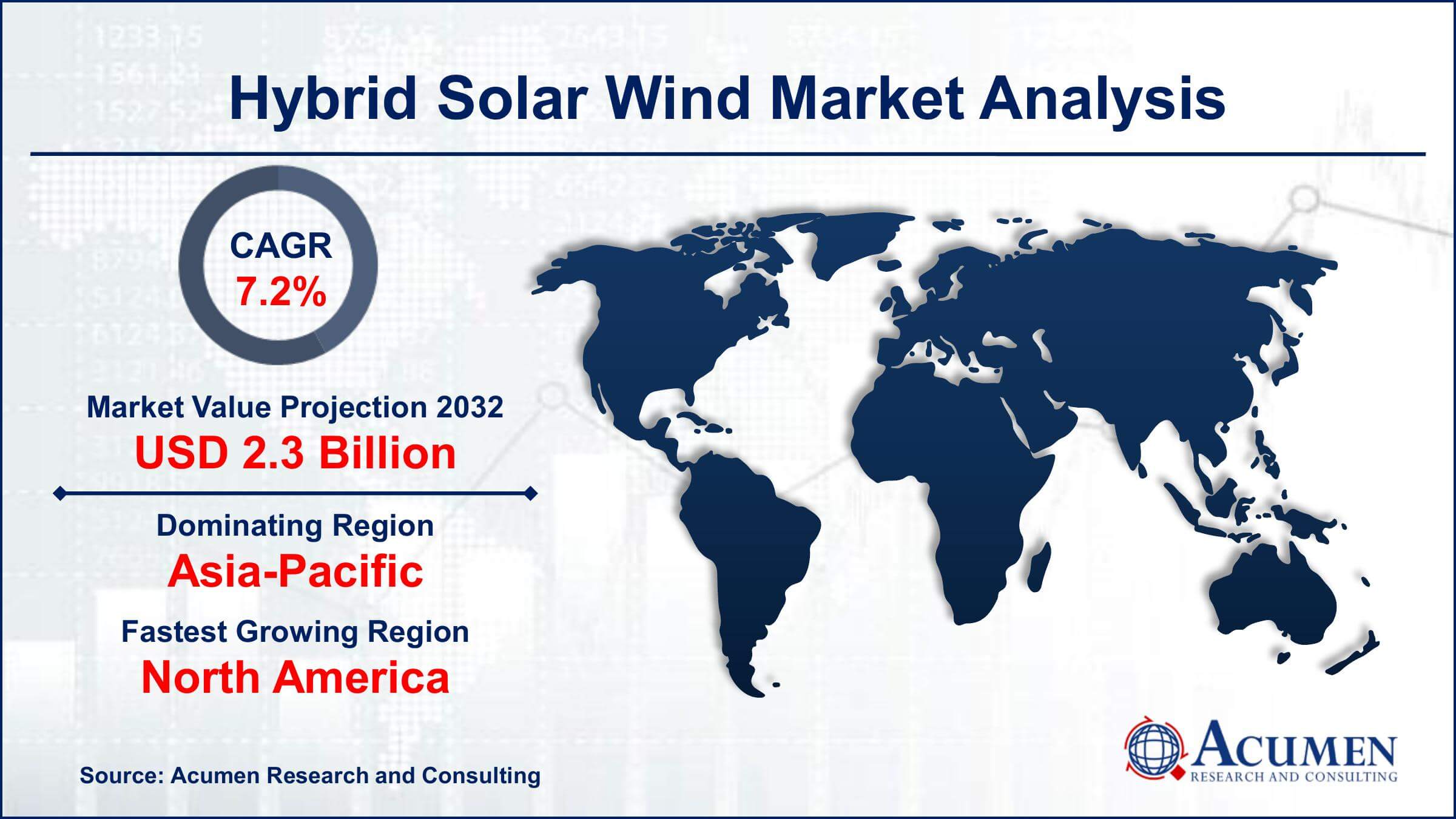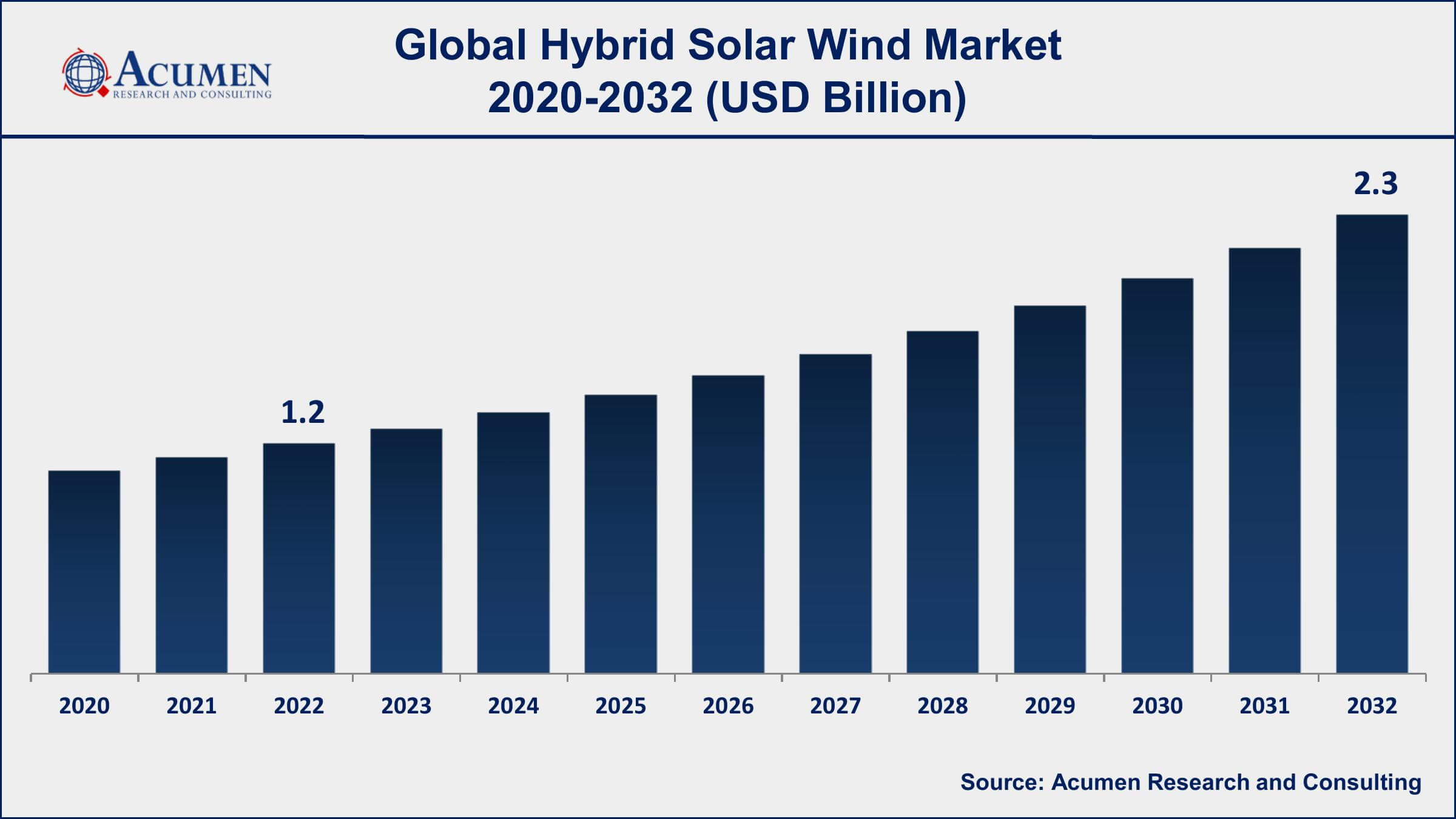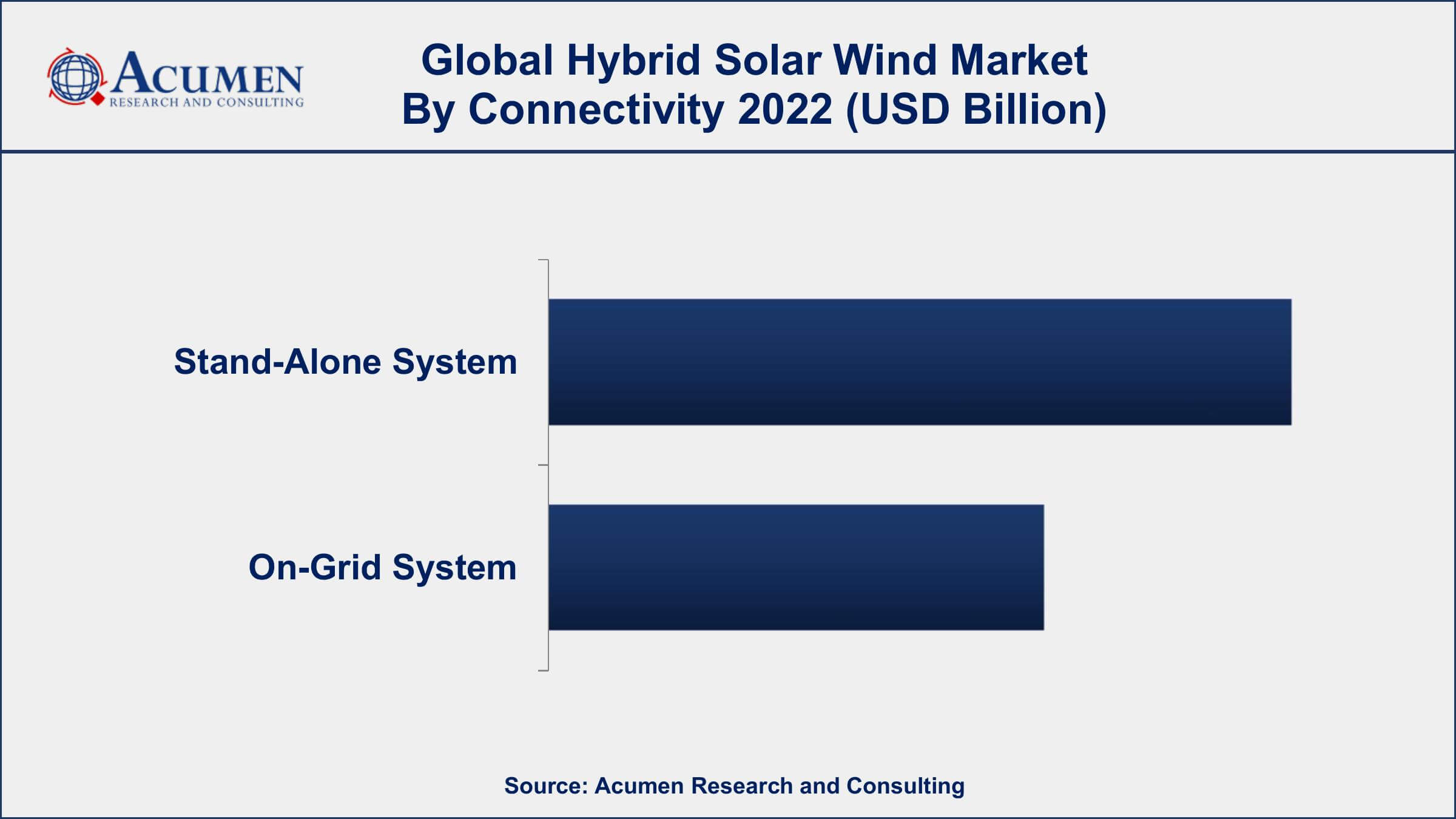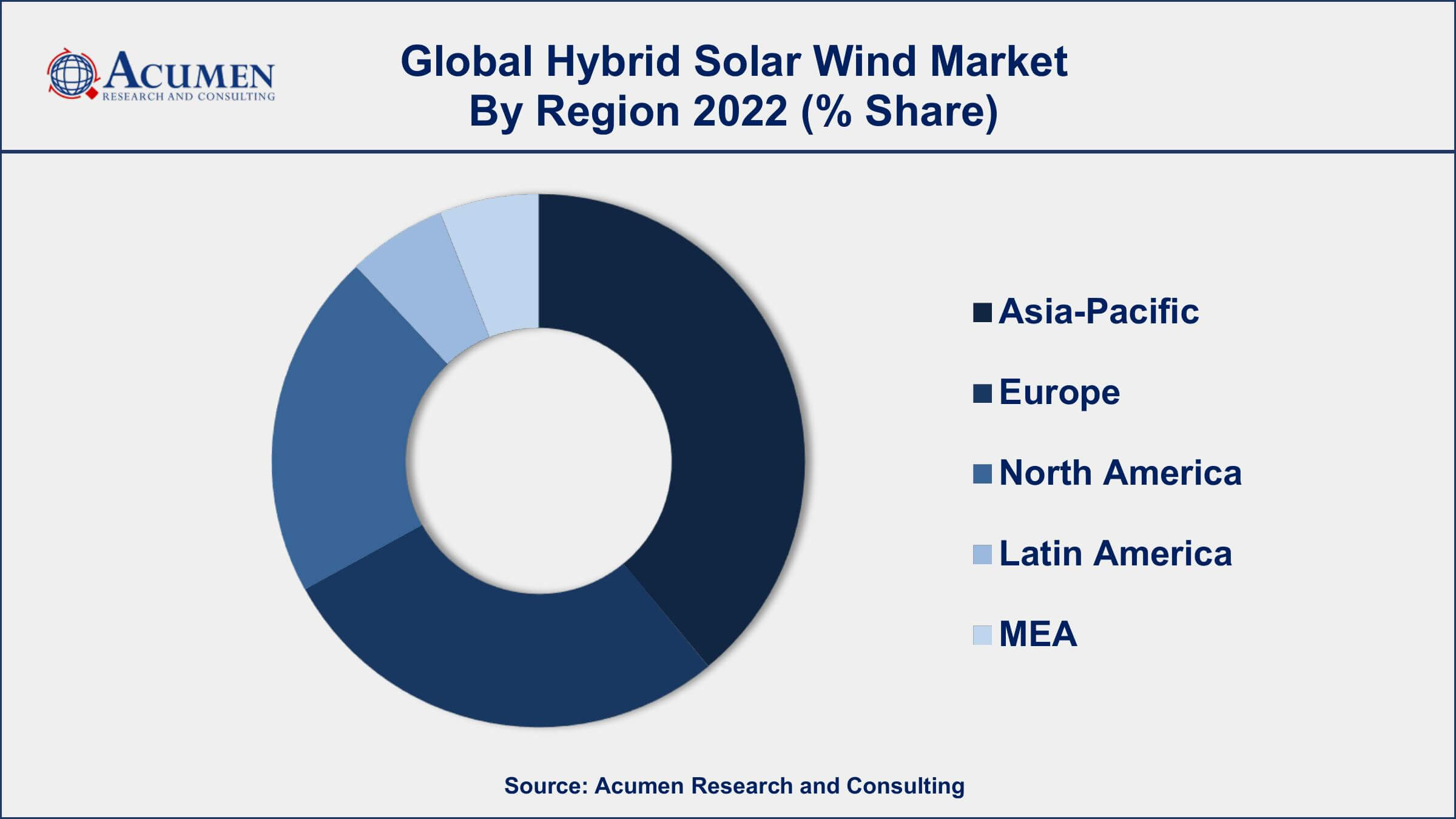Hybrid Solar Wind Market | Acumen Research and Consulting
Hybrid Solar Wind Market Size - Global Industry, Share, Analysis, Trends and Forecast 2023 - 2032
Published :
Report ID:
Pages :
Format :
The Global Hybrid Solar Wind Market Size accounted for USD 1.2 Billion in 2022 and is projected to achieve a market size of USD 2.3 Billion by 2032 growing at a CAGR of 7.2% from 2023 to 2032.
Report Key Highlights
- Global hybrid solar wind market revenue is expected to increase by USD 2.3 Billion by 2032, with a 7.2% CAGR from 2023 to 2032
- Asia-Pacific region led with more than 36% of hybrid solar wind market share in 2022
- The International Renewable Energy Agency (IRENA) reported that the global installed capacity of hybrid solar-wind power systems reached 1.1 GW in 2018, up from 591 MW in 2015
- According to the International Renewable Energy Agency (IRENA), global installed wind and solar capacity reached 1,330 GW in 2020, with wind accounting for 726 GW and solar accounting for 704 GW
- According to the US Energy Information Administration (EIA), the average capacity factor for wind power in the US was 39% in 2020, while utility-scale solar power had a capacity factor of 25%
- Stand-alone systems category dominated the market in 2022, accounting for more than 60% of connectivity
- Increasing demand for renewable energy sources, drives the hybrid solar wind market size

Hybrid solar wind is a renewable energy system that combines the power generation capabilities of both solar and wind sources. The system typically includes solar panels, wind turbines, energy storage, and a control system that optimizes the power output from both sources.
The growth of the hybrid solar wind market has been significant in recent years, driven by several factors such as increasing demand for renewable energy, declining costs of solar and wind technologies, and government incentives and policies that encourage the deployment of these systems. The market growth for hybrid solar wind is expected to continue in the coming years, as more countries and companies aim to reduce their carbon footprint and transition to clean energy sources. The deployment of hybrid solar wind systems can provide several benefits such as increased energy security, reduced reliance on fossil fuels, and cost savings in the long run.

Global Hybrid Solar Wind Market Trends
Market Drivers
- Increasing demand for renewable energy sources
- Government policies and incentives to promote renewable energy adoption
- Declining costs of solar and wind technologies
- Rising awareness of the environmental impact of fossil fuels
Market Restraints
- High initial investment costs
- Intermittent nature of renewable energy sources
- Lack of infrastructure and transmission lines in remote areas
Market Opportunities
- Integration of energy storage systems to address intermittency issues
- Development of hybrid systems with higher power output and efficiency
Hybrid Solar Wind Market Report Coverage
| Market | Hybrid Solar Wind Market |
| Hybrid Solar Wind Market Size 2022 | USD 1.2 Billion |
| Hybrid Solar Wind Market Forecast 2032 | USD 2.3 Billion |
| Hybrid Solar Wind Market CAGR During 2023 - 2032 | 7.2% |
| Hybrid Solar Wind Market Analysis Period | 2020 - 2032 |
| Hybrid Solar Wind Market Base Year | 2022 |
| Hybrid Solar Wind Market Forecast Data | 2023 - 2032 |
| Segments Covered | By Connectivity, By End-use, And By Geography |
| Regional Scope | North America, Europe, Asia Pacific, Latin America, and Middle East & Africa |
| Key Companies Profiled | Siemens Gamesa Renewable Energy, General Electric, Vestas Wind Systems, Suzlon Energy, Goldwind Science and Technology, Enercon GmbH, Nordex SE, Envision Energy, Inox Wind, and Ming Yang Smart Energy Group. |
| Report Coverage |
Market Trends, Drivers, Restraints, Competitive Analysis, Player Profiling, Covid-19 Analysis, Regulation Analysis |
The hybrid solar-wind market is evolving rapidly, driven by the increasing demand for renewable energy and the need for reliable and sustainable power sources. As renewable energy technologies continue to improve and become more cost-effective, hybrid solar-wind power systems are expected to play an increasingly important role in the global energy mix.
One of the key drivers of this market evolution is the shift towards decarbonization, with many countries setting ambitious targets to reduce their greenhouse gas emissions. Hybrid solar-wind power systems are well-suited to help achieve these goals, as they provide a reliable and renewable source of electricity without contributing to climate change. This is particularly important in sectors such as transportation, where electrification is seen as a key strategy for reducing emissions.
Another factor driving the growth of the hybrid solar-wind market is the increasing focus on energy resilience and security. With the threat of natural disasters and other disruptions to the power grid, hybrid solar-wind systems can provide a more stable and reliable source of electricity. This is especially important in remote or off-grid areas, where access to the electricity grid is limited, and where the use of diesel generators can be expensive and environmentally damaging.

Hybrid Solar Wind Market Segmentation
The global hybrid solar wind market segmentation is based on connectivity, end-use, and geography.
Hybrid Solar Wind Market By Connectivity
- Stand-Alone System
- On-Grid System

In terms of connectivity, the stand-alone system segment has seen significant growth in the hybrid solar wind market in recent years. The growth of this segment is being driven by the rising demand for renewable energy in remote areas, where access to grid power is limited or nonexistent. One of the main advantages of stand-alone hybrid solar wind systems is their ability to provide reliable power supply in remote areas, which can help to improve living standards and support economic development. These systems can also help to reduce dependence on fossil fuels and lower greenhouse gas emissions, contributing to global efforts to combat climate change. In addition, the integration of energy storage systems in stand-alone hybrid solar wind systems can help to address intermittency issues and ensure a stable power supply, further driving the growth of this segment. With the development of more efficient and cost-effective hybrid solar wind technologies, the stand-alone system segment is expected to continue to grow in the coming years.
Hybrid Solar Wind Market By End-use
- Residential
- Industrial
- Commercial
According to the hybrid solar wind market forecast, the industrial segment is expected to witness significant growth in the coming years. One of the main advantages of hybrid solar wind systems in the industrial segment is their ability to provide a stable and reliable power supply, which can help to reduce downtime and improve operational efficiency. Hybrid solar wind systems can also help to lower energy costs and reduce greenhouse gas emissions, contributing to sustainability goals and improving corporate social responsibility. The industrial segment in market is also being driven by government incentives and regulations that encourage the adoption of renewable energy sources in industries. For example, in some countries, industrial operations are required to meet certain emissions targets, which can be achieved by transitioning to clean energy sources such as hybrid solar wind systems.
Hybrid Solar Wind Market Regional Outlook
North America
- U.S.
- Canada
Europe
- U.K.
- Germany
- France
- Spain
- Rest of Europe
Asia-Pacific
- India
- Japan
- China
- Australia
- South Korea
- Rest of Asia-Pacific
Latin America
- Brazil
- Mexico
- Rest of Latin America
The Middle East & Africa
- South Africa
- GCC Countries
- Rest of the Middle East & Africa (ME&A)

Hybrid Solar Wind Market Regional Analysis
Geographically, Asia-Pacific is leading the hybrid solar wind market for several reasons, including its large population, rapid economic growth, and increasing demand for reliable and sustainable energy sources. The region has been experiencing significant economic growth, which has led to an increase in energy demand, and the need for energy security has become a top priority for many countries. Hybrid solar wind systems have emerged as a viable solution to meet this growing demand for energy while reducing greenhouse gas emissions and improving energy security.
In addition, the Asia-Pacific region has been experiencing a decline in the cost of renewable energy technologies, including solar and wind, making hybrid solar wind systems more economically viable. This has further encouraged the adoption of hybrid solar wind systems in the region, particularly in remote areas with limited access to grid power.
Hybrid Solar Wind Market Player
Some of the top hybrid solar wind market companies offered in the professional report include Siemens Gamesa Renewable Energy, General Electric, Vestas Wind Systems, Suzlon Energy, Goldwind Science and Technology, Enercon GmbH, Nordex SE, Envision Energy, Inox Wind, and Ming Yang Smart Energy Group.
Frequently Asked Questions
What was the market size of the global hybrid solar wind in 2022?
The market size of hybrid solar wind was USD 1.2 Billion in 2022.
What is the CAGR of the global hybrid solar wind market from 2023 to 2032?
The CAGR of Hybrid Solar Wind is 7.2% during the analysis period of 2023 to 2032.
Which are the key players in the hybrid solar wind market?
The key players operating in the global market are including Siemens Gamesa Renewable Energy, General Electric, Vestas Wind Systems, Suzlon Energy, Goldwind Science and Technology, Enercon GmbH, Nordex SE, Envision Energy, Inox Wind, and Ming Yang Smart Energy Group.
Which region dominated the global hybrid solar wind market share?
Asia-Pacific held the dominating position in hybrid solar wind industry during the analysis period of 2023 to 2032.
Which region registered fastest CAGR from 2023 to 2032?
North America region exhibited fastest growing CAGR for market of hybrid solar wind during the analysis period of 2023 to 2032.
What are the current trends and dynamics in the global hybrid solar wind industry?
The current trends and dynamics in the hybrid solar wind industry include increasing demand for renewable energy sources, and declining costs of solar and wind technologies.
Which connectivity held the maximum share in 2022?
The stand-alone system connectivity held the maximum share of the hybrid solar wind industry.


